Complying with consumer law when making environmental claims in the fashion retail sector
Published 18 September 2024
Introduction
The Competition and Markets Authority (CMA) has published this compliance document to help explain how fashion retail businesses can follow the Green Claims Code (‘the Code’) when making environmental claims.
It draws on the conclusions from the CMA’s recent investigation which led to three fashion businesses (ASOS, Boohoo and George at Asda) giving formal commitments to make certain changes to the way they make environmental claims. These undertakings are relevant to businesses across the fashion retail sector.
We aim to provide businesses with practical advice to help them comply with the principles of the Code and with the consumer protection law which underpins it, to ensure that consumers are not misled and to help create a level playing field for fair dealing businesses.
As well as thinking about the specific issues highlighted here, businesses need to look at all their practices in the round. Businesses should consider whether they need to make other changes to ensure they comply with the law.
Why this matters to your business
Consumers are increasingly demanding products and services which minimise harm to, or have a positive effect on, the environment. It is essential that they can make informed choices based on environmental claims that they can trust.
Your business must comply with consumer protection law when making environmental claims. If you don’t, you risk facing enforcement action. This could result in you being ordered to change your practices, and you may have to pay money back to your customers. Once the consumer enforcement provisions of the Digital Markets, Competition and Consumers Act 2024 (‘the Act’) come into force, you could be fined up to 10% of your worldwide turnover if you break the law. The Act’s consumer enforcement provisions are set out in Part 3 of the Act.
Scope of this document
This compliance document is relevant for all businesses which make environmental claims about:
- clothing
- footwear
- fashion accessories
- related services, for example packaging, delivery and returns
Each business in the supply chain has a responsibility to ensure that its claims are accurate and substantiated. The focus in this document is on fashion retail including retailers who sell their own or third-party products via marketplaces. It will also be relevant to:
- manufacturers and suppliers (including third party branded suppliers)
- wholesalers and distributors (see paragraphs 2.20 and 2.21 of the Code)
This document applies to environmental claims about your products, services, processes, brands or business as a whole. For ease of reading, in this document we use the word ‘products’ which you should interpret as including services, processes, brands and businesses, where relevant.
Make your environmental claims clear and accurate
All your business’s environmental claims must be clear and accurate. This is the case whether they’re made on a product (including on labels), in advertising materials, in store or online. This includes content on your own website or app or someone else’s, for example, on social media.
Don’t hide important information
When you present information to your customers, think about how and where you include the important information that is needed to make sure a claim is not misleading. You should also think about the overall impression you are creating. Important information should be clear and prominent. In other words, it should be:
- in plain language and accurate
- presented in a way that consumers can easily identify, read and understand the relevant information as a whole
- clearly visible, and not hidden by other information shown to consumers such as information displayed in signs, banners and as pop-up text and images that may be seen online
- presented close to the environmental claim made
Your customers should not have to take further action such as following a hyperlink, scanning a QR code or expanding a drop-down list to access important information. Important information must be displayed close to the location of the claim, for example on the same side of a tag, or next to the claim on a website. Where you provide supporting or further information, this should not contradict the claim itself.
You can provide certain supporting or further information separate to the claim. For these limited types of information, it may be appropriate to display the information as shown in box 1 below:
Box 1: Information that can be displayed separately to the claim
In some situations, information can be presented:
-
online, using tools which allow a consumer to reveal further information which is immediately displayed (for example, a drop-down field), as long as this tool is in the same location or webpage as the claim and is clearly and prominently labelled or signposted to the consumer
-
in store, where the claim is made on a product tag, on the back of that product tag, or on an immediately adjacent tag, as long as the location of the relevant information is clearly and prominently signposted close to the claim
You will find examples of where this may be appropriate for particular types of information in the ‘location boxes’ below. You will need to think about the particular claim being made and overall presentation of information to ensure your claims are not misleading.
Depending on how and where you make a claim, there might be limits on how much information you are able to include. Those limits do not give your business an excuse to miss out or hide important information about a claim. If there is not enough space for the information, and the claim could be misleading without it, think carefully about whether it is appropriate to make the claim at all.
If you make a claim which is qualified by other information, clearly state the qualifications. The less prominent any qualifying information is, and the further away it is from any main claim being made, the more likely it is that the claim could mislead consumers.
Before making a claim, ask yourself if:
- the claim is clear
- important information relevant to the claim, such as qualifying or other important information that is needed to ensure a claim is not misleading, is displayed in the right way
Avoid using unclear terms
Broader, general or absolute claims - like ‘green’, ‘sustainable’ or ‘eco-friendly’ - are much more likely to be inaccurate and to mislead consumers. The meaning of words like these is unclear. Consumers are likely to assume that the product as a whole has a positive environmental impact, or at least no adverse impact. Unless you can prove that is the case, you risk falling short of your legal obligations.
Before making a claim, ask yourself if:
- the claim is accurate
- the meaning of any term used is clear to consumers
- you have evidence to support any broad or general term that has been used
Do not use imagery and icons in a misleading way
Do not use visual signs such as logos, icons and imagery in a way that gives or reinforces a misleading impression of the product’s impact on the environment.
Before making a claim, ask yourself if:
-
the overall impression that the claim creates is misleading
-
more information is needed to explain the logo, icon or imagery used
Example 1
Social media post:
‘A planet-loving jacket’
It could be misleading to refer to an item as ‘planet-loving’ and include an earth logo or leaf symbol against a product without any explanation, when the basis for the claims and presentation is limited. For example, if the reason is because the product can be recycled under certain circumstances, the overall presentation is likely to give a misleading impression of the environmental credentials of the product.
The use of imagery in this context would be less likely to contribute to a misleading impression if, for example, a recycle logo such as a mobius loop image was included next to a statement that sets out how the product can be recycled (such as noting that the product ‘can be recycled in store’ or ‘can be recycled via our take-back scheme’ where this is the case).
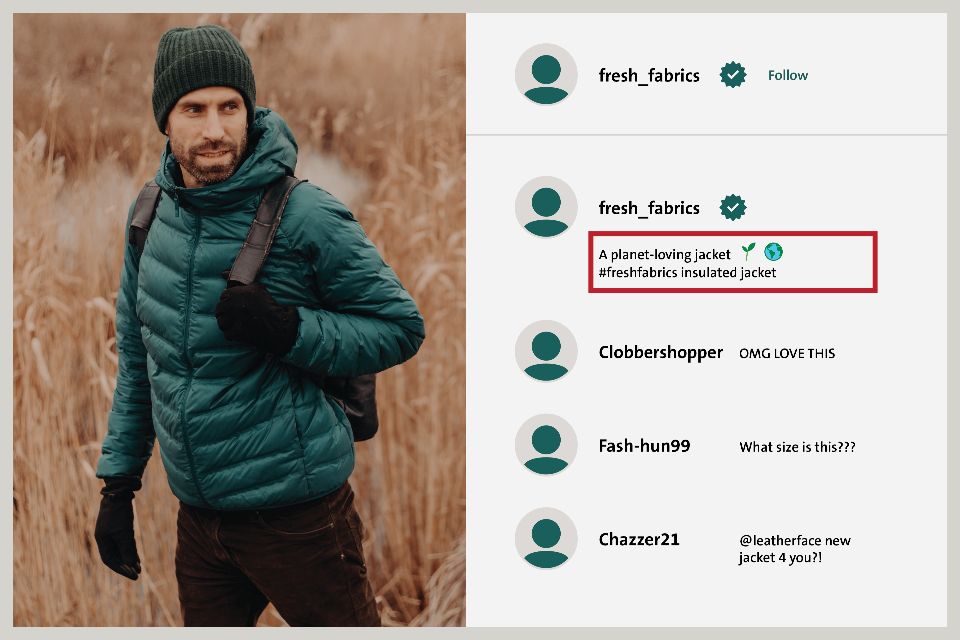
Image description: In an example social media post, the fresh_fabrics account claims that an insulated jacket is ‘planet-loving’. Several other users have reacted positively to the post, which includes a photo of a model wearing the jacket.
Ensure comparisons are clear
If you make comparisons in your environmental claims, such as saying that a product has a lower carbon footprint than another, you should set out at least a summary of the basis for any comparisons made. This summary should be clear and prominent.
Consumers should be able to make informed choices about competing products and businesses, or between different versions of a similar product.
Before making a comparative claim, ask yourself if:
-
the claim is comparing like for like
-
it’s clear to consumers what is being compared and how the comparison is being made
-
the basis of the comparison is fair and clear
Information location:
Unless this is clear from the context, an explanation of the basis of the comparison should be close to the claim. For example, where the claim is on a product tag, the basis of the comparison should be on the same side of the product tag as the claim itself. Where the claim is online, the basis of the comparison should be clear, located close to the claim and be visible without the consumer needing to take further action – for example, they should not need to click on a link or scan a QR code to access the information.
Example 2
Social media post for clothing brand
‘Our sustainable collection is formed using better materials and less damaging production techniques.’
Using comparative terms would be problematic where the basis for the comparison is not clear, such as statements which refer to ‘better materials’ or products made ‘with less damaging production techniques’. In these examples, it is not clear what the items are being compared to. Stating that something is ‘more sustainable’ or ‘less harmful’ or ‘better’ without providing any other information to explain the claim could mislead consumers.
A statement like this would be more likely to comply with the law, given it provides a clearer basis for the comparison made: ‘Our new denim range uses 50% less water than our previous range in the washing, ageing and finishing process’.
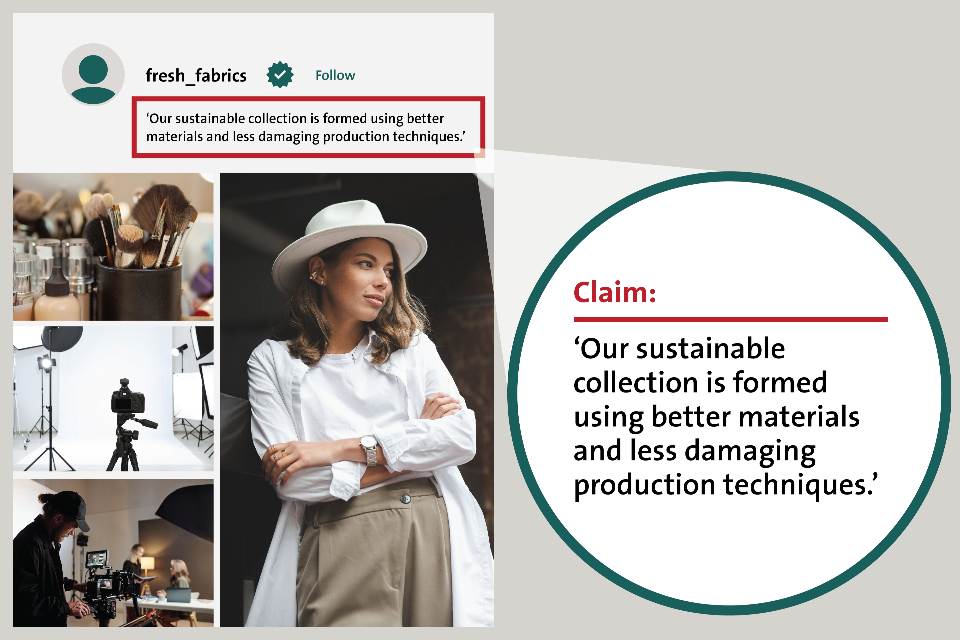
Image description: In an example social media post, fresh_fabrics claims that ‘our sustainable collection is formed using better materials and less damaging production techniques.’ Next to the claim are some photos related to the collection.
Explain clearly any action a consumer needs to take
If you make a claim which is only true if the consumer takes certain action, that action needs to be clearly stated (unless it’s clear from the context).
Before making a claim, ask yourself if:
-
you need to set out the circumstances that apply to any claim you are making, or explain them in more detail
-
the action the consumer would need to take is clear
Information location:
Unless this is clear from the context, the consumer action needed should be stated close to the claim, for example if the claim is on a product tag, the action needed should be on the same side of the product tag as the claim itself. Where the claim is online, this information should be clear, located close to the claim and be visible without the consumer needing to take further action – for example, the consumer should not need to click on a link or scan a QR code to access the information. Any supporting or further information (for example specific disposal instructions or appropriate recycling locations) may be displayed as set out in box 1 above.
Example 3
Social media post:
‘A kid’s winter coat that’s also eco-friendly? Yes, please’
It could be misleading to claim that a product is ‘sustainable’, ‘green’ or ‘eco-friendly’, if you don’t explain that the reason for this is that the consumer can take certain action to prolong use of the product. For example, because the sleeves have a hidden hem that can be unpicked to make them longer, so the item can be worn for longer by a growing child. Important information needs to be clear so consumers can make an informed decision.
Also, terms like ‘eco-friendly’ are difficult for consumers to interpret and can exaggerate the environmental benefits of a product. Consumers may wrongly understand that the product has a positive environmental impact as a whole.
A statement like this would be more likely to comply with the law:
‘A kid’s winter coat that’s made to be worn for longer, with sleeves I can extend? Yes, please’
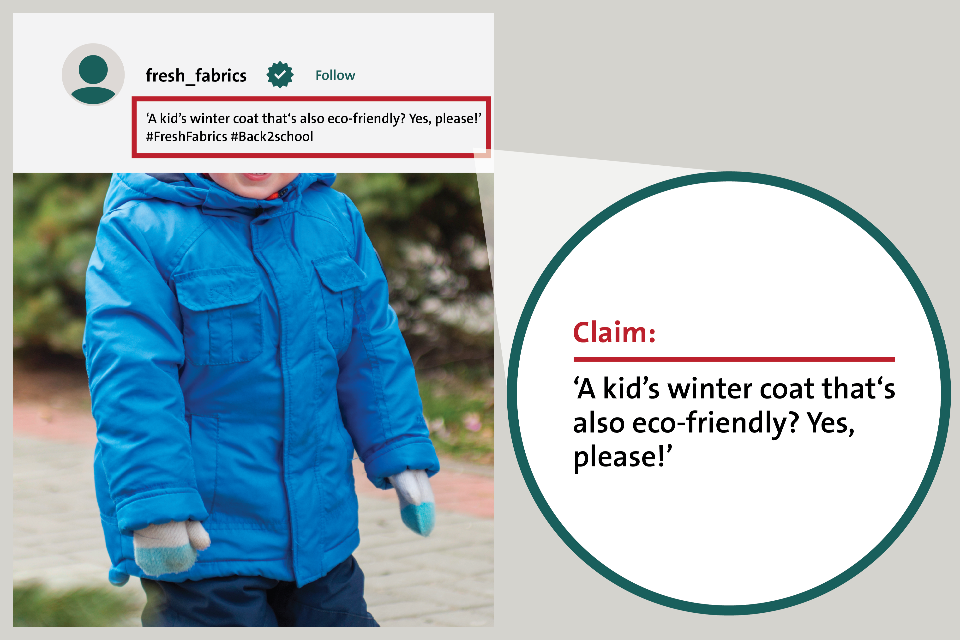
Image description: In an example social media post, fresh_fabrics claims that a kid’s winter coat is ‘eco-friendly’. The post includes a photo of a child wearing the coat.
Be clear when using filters and other navigational tools
If you use navigational tools like filters or drop-down menus on your website or app to allow customers to find products based on their environmental credentials, then you should present these tools in a way that does not mislead consumers.
Avoid giving the impression that a group of products, or individual products in the group, are better for the environment than they really are. This includes creating a misleading impression of the product characteristics. For example, avoid using words like ‘sustainable’ in your filters, unless your products are truly sustainable based on verifiable criteria. Instead, refer to specific characteristics, like ‘50%+ recycled’.
Only products that meet the characteristics of the navigational tool should be included in search results.
Before grouping products with a navigational tool, ask yourself if:
-
it is clear which conditions or criteria apply for products to be included in the filter
-
products included in the filter actually meet the criteria
Example 4
A website menu includes the following option for ‘recycled dresses’: Retailbrand.com main page > all clothing > sustainability > recycled dresses
This contains a selection of dresses which are only partially made from recycled materials or do not contain any recycled materials.
Referring to the group of products as ‘recycled’ may lead consumers mistakenly to believe all the dresses in the product group are entirely made of recycled materials.
A filter which clearly states the minimum criteria for inclusion, such as ‘at least 50% recycled content’ would be more likely to comply with the law.
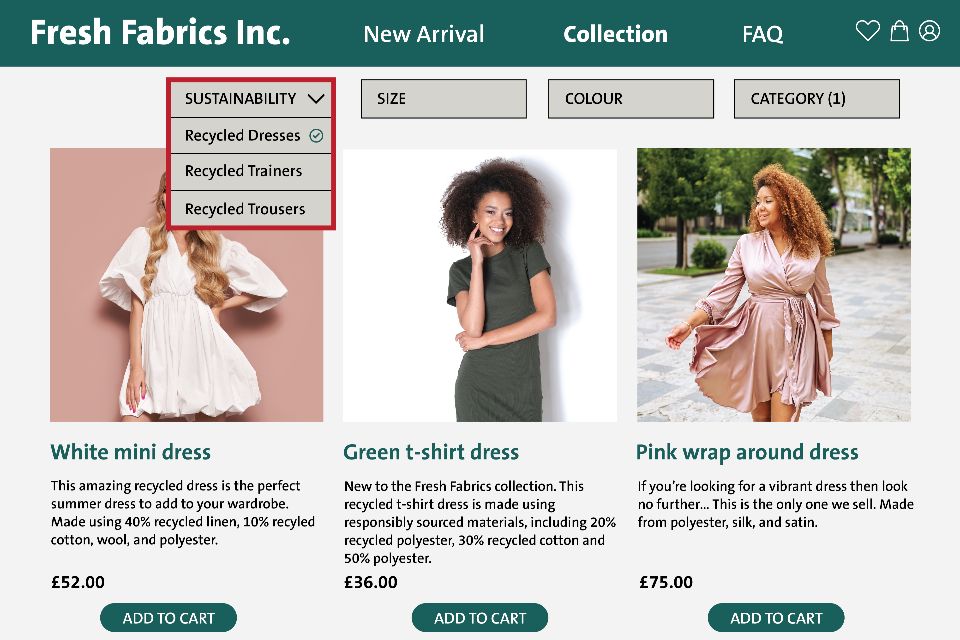
Image description: On the Fresh Fabrics Inc. website, a filter shows the user options for ‘recycled’ dresses, trainers and trousers. The filter label is ‘sustainability’. The ‘recycled dresses’ option is ticked and three dresses are shown with varied product information.
Product ranges
Your business might sell a range of items, grouped according to specific criteria relating to their impact on the environment. Examples of environmental product ranges include collections, capsule collections and limited releases of products (for example, a time-limited ‘drop’).
Make the criteria for such product ranges clear. If you don’t, consumers might mistakenly understand that the products in the range have a lower or more beneficial impact on the environment than they actually do.
Explain the range criteria
Make the full criteria for the range available to consumers. The full criteria should be displayed clearly and prominently. If you are selling your range in store, this should be in an appropriate location where consumers can see it before making a purchase. If you are selling online, the full criteria should be located where it is easy for consumers to find them.
Provide a clear and prominent summary of the criteria when a range is advertised or marketed, or a product is advertised or marketed as being part of the range. Include any minimum thresholds that are part of the criteria and provide access to further details, like a link to the full criteria.
Whenever products in a range are available to purchase, for example on a product webpage, in store or directly via social media, at a minimum you should also provide a summary of the criteria. The summary must include any minimum thresholds that are part of the criteria and provide access to further details, such as a link to where the full criteria are available.
Information location:
When a product is offered for purchase, for example on a product webpage, the summary of the range criteria may be displayed as set out in box 1 above.
Don’t mislead consumers with the name of your range
Do not mislead consumers with the name of your range. Terms that are unclear or broad might give the impression that products in the range are better for the environment than they are.
Make sure range marketing is not misleading
Do not include products as part of a range unless the product meets the relevant criteria for inclusion in the range.
If you are marketing or advertising a range and you include a hyperlink or refer to products (for example, in a social media post or on an in-store poster), the products that you mention should meet the criteria for inclusion in that range.
Before making a range-related claim, ask yourself if:
-
the range name is misleading
-
the range criteria are available, and a summary is provided
-
all products in the range meet the criteria
Example 5
Extract from website text:
‘Explore our exclusive, curated range of environmentally conscious fashion products. Step into the Sustainable Edit and discover a selection of beloved brands and products crafted from responsible materials all in one place.’
By describing the range as ‘environmentally conscious’, ‘sustainable’ and made from ‘responsible materials’, without any further explanations or qualifications, consumers may be misled into believing that items in the range are more beneficial or less harmful to the environment than they actually are.
The range description would be less likely to mislead consumers if ambiguous or unclear terms are not used to describe the range and the criteria for including items in the range are provided. The following example is less likely to mislead consumers as the range criteria are clearer:
‘Explore our exclusive and curated range and discover a selection of beloved brands and products made using at least 75% recycled or organic content all in one place. For the full range criteria, click this link…’
You should ensure the name of any such range does not risk misleading consumers.

Image description: The Fresh Fabrics Inc. website invites users to ‘explore our exclusive, curated range of environmentally conscious fashion products. Step into Sustainable Edit and discover a selection of beloved brands and products crafted from responsible materials all in one place.’
Describe fabrics clearly and precisely
You might make environmental claims about a product because it contains certain types of fabric.
You should refer to the objective properties of each fabric – like, ‘recycled polyester’ or ‘organic cotton’ rather than by a more subjective or ambiguous description like ‘environmentally-conscious nylon’ or ‘responsible cotton’.
Do not imply that a product is entirely made of a single fabric if that is not true. Don’t describe a product as, for example, ‘recycled’ or ‘organic’ if it contains fibres that are not recycled or organic, unless the proportion of non-recycled or non-organic fibres is negligible. Generally, excluding components such as buttons, zippers and threads from this assessment is unlikely to make the claim misleading.
If you describe a product as being made with fibre with a particular characteristic, like ‘recycled’ or ‘organic’ fibres, or where environmental claims are made based on the product’s fabric composition, you should set out clearly:
- the specific percentage of relevant fibres in that product
- the minimum percentage of relevant fibres that the product must have
You must have evidence to support the percentage information you provide. For example, certificates obtained as part of supplier checks or appropriate testing.
Before making a fabric composition claim, ask yourself if:
-
fabrics are referred to by their intrinsic characteristic rather than ambiguous terms
-
the product is made entirely from the relevant fabric, where this is the impression given
-
the percentages of the relevant fabric to which the claim relates are made clear
Information location:
The fibre percentage may be displayed as set out in box 1 above.
Example 6
Product title on webpage:
‘Organic cotton cardigan in bright blue’
The product information, which is not obviously visible on the product page, states: Product composition: 50% organic cotton, 50% cotton.
Use of the term ‘organic’ in a product title when a product only contains 50% organic content is likely to be misleading.
Since the title does not provide detail of the proportion of organic content, the consumer may mistakenly believe that the entire product is made of organic cotton.
Using a product title which accurately reflects the product’s fabric characteristics would be less likely to mislead consumers. The following example is less likely to mislead consumers: ‘Bright blue cotton cardigan with 50% organic cotton’
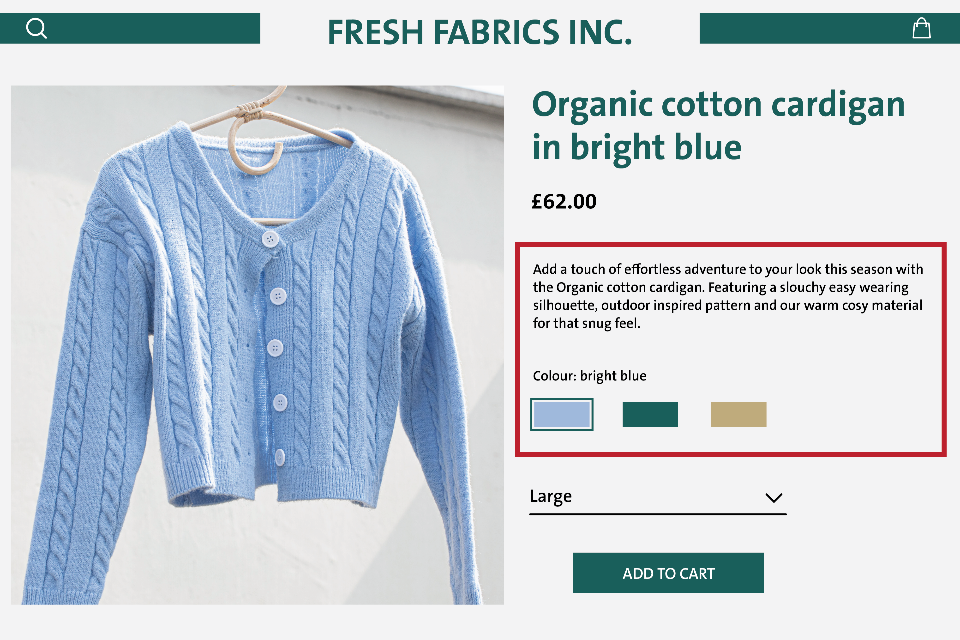
Image description: A cardigan is listed for sale on the Fresh Fabrics Inc. website. The title describes it as an ‘organic cotton cardigan in bright blue’. Description: ‘Add a touch of effortless adventure to your look this season with the Organic cotton cardigan. Featuring a slouchy easy wearing silhouette, outdoor inspired pattern and our warm cosy material for that snug feel.’ The page does not include any obviously visible information about the materials used to create the cardigan.
Affiliations and accreditations
Don’t mislead consumers when referring to affiliations and accreditations in respect of individual products
There are affiliation and accreditation schemes that provide certain assurances, such as about raw materials and fabrics. Some affiliation or accreditation schemes prove that a product has particular characteristics. You should only refer to affiliation or accreditation schemes in relation to an individual product where the product has those particular characteristics.
This doesn’t prevent your business from providing clear and accurate information about affiliation and accreditation schemes, such as:
-
telling consumers about your affiliations or accreditations more generally
-
including a product within a range where the affiliation or accreditation is relevant to the product (for example, where a particular type of fabric that a product is made from is sourced according to an affiliated scheme)
-
telling consumers that purchasing a product may indirectly support an affiliation or accreditation scheme (for example, by contributing credits to a mass balance chain[footnote 1]). You must clearly and prominently state close to the claim that the individual product’s composition may not be impacted by the relevant affiliation or accreditation where this is the case. This could be, for example, because the mass balance chain of custody arrangements cannot trace the fabric composition of individual products
Provide further details about affiliations and accreditations
If you make an environmental claim which is based on or references an affiliation or accreditation scheme, then you should provide:
-
a summary of the environmental benefits which can properly be associated with this
-
where relevant, details about any material connection you have to that third party or scheme (for example which may have an impact on their independence)
-
a reference to where further details can be found (for example, through a hyperlink or QR code)
-
a clear and prominent link to the third party’s or accreditation scheme’s website
Information location:
These further details about affiliations and accreditations may be displayed as set out in box 1 above.
Before making a claim relating to an affiliation or accreditation scheme, ask yourself if:
-
the claim creates a misleading impression about the product characteristics
-
the benefits of the scheme have been summarised
-
any connection you have to the scheme is clear
-
a link to the scheme website has been provided
-
reference to further details has been provided
Example 7
An on-product claim:
‘T-shirt made from 100% GOOD FABRIC Scheme material’*
*The GOOD FABRIC Scheme is a fictional example used for the purposes of illustration in this compliance document, under which fabrics are sourced through a mass balance credit system.
This statement is more likely to mislead consumers if the material being referenced cannot be traced to the final product under the accreditation scheme, which may be the case in mass balance schemes.
The following example statement is less likely to mislead consumers – ‘By buying this T-shirt you are supporting the GOOD FABRIC Scheme’s pesticide-free farming programme. This T-shirt may contain material that is conventionally farmed, find out more via this link.’ With a link or QR code leading to further details about the scheme.

Image description: This Fresh Fabrics Inc. webpage claims that a t-shirt is ‘made from 100% GOOD Fabric Scheme material’. Above the claim is a logo for the Good Fabric Collection.
Make it clear if a claim is based on specific parts of a product’s life cycle
If you make a claim based on a specific part of a product’s life cycle, then you should provide a clear and prominent summary of the aspect of the life cycle to which the claim relates, as well as access to further information.
Information location:
The summary of the relevant aspect of the life cycle should be provided close to the claim. For example, if the claim is on a product tag, the information should be on the same side of the product tag as the claim itself. Where the claim is online, this information should be clear, located close to the claim and be visible without the consumer needing to take further action – such as clicking on a link or scanning a QR code.
Before making a claim, ask yourself if:
- the claim relates to a specific part of the product life cycle. If so, is this clear?
Example 8
Website text: Description of a product range on the website:
‘Discover fibres and fabrics that minimise water usage and waste, making your purchases environmentally friendly.’
This statement would be likely to mislead consumers, if the reference to minimising water usage and waste in fact relates only to the raw material production stage. Without this being made clear, the statement above may suggest the claim relates to the entire manufacturing process of garments in the range.
The following example statement is more likely to comply with the law:
‘This garment is made using a cutting process that minimises waste’
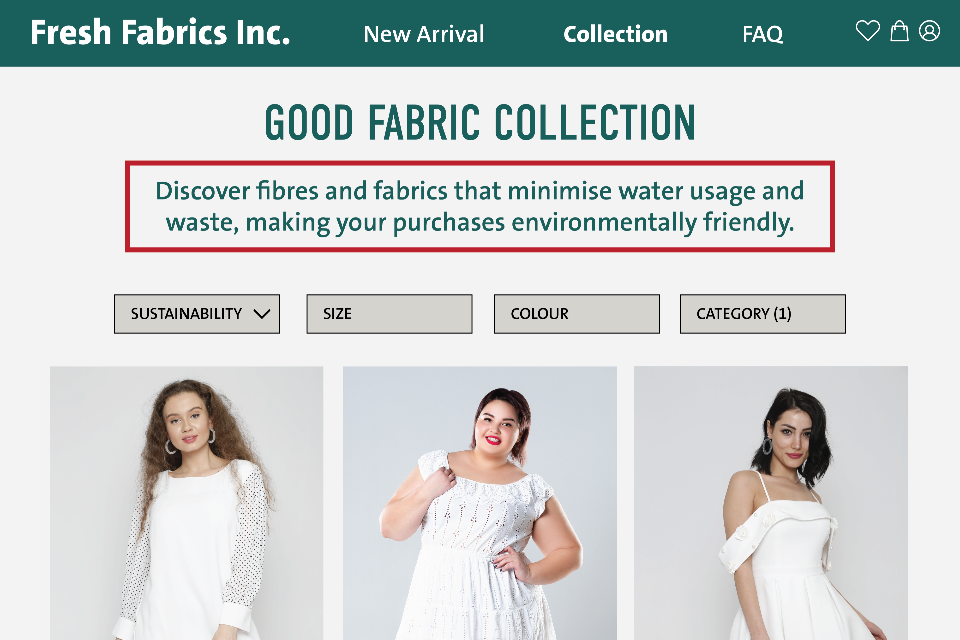
Image description: This webpage for the Good Fabric Collection invites you to ‘discover fibres and fabrics that minimise water usage and waste, making your purchases environmentally friendly’.
Ensure environmental targets are presented clearly
You should only make environmental claims that are based on, or that reference corporate targets where you have a clear and verifiable strategy in place to meet those targets. Make sure that consumers can understand the terms you use to explain claims. Do not use environmental claims that create a misleading impression about the impact of your fashion retail business as a whole on the environment.
You should provide at least a clear and prominent summary of the nature of the target. Include further information about:
-
what the target is aiming to achieve
-
the date on which the target is expected to be met
-
the main ways by which you intend to achieve the target
You could provide this further information through a link, a web address, hyperlink, QR code or another way.
Before making a claim relating to a target, ask yourself if:
-
there is a clear and verifiable strategy in place to deliver the target, and if so, has this been explained to consumers
-
the target creates an accurate impression of the business’s efforts to reduce its environmental impact
-
the target is up to date
Example 9
Sustainability webpage extract:
‘We are committed to creating a better world and promoting sustainability through all of our actions.’
This statement is a broad, aspirational and unsubstantiated claim that is likely to be misunderstood by consumers. Similarly, statements such as ‘we are on a journey’ or ‘it’s the beginning’ or similar phrasing may create the impression that further improvements are still to come, without being specific about what these are. No detail is given about the ways in which the business will make changes.
The following example statement to explain the target would be more likely to comply with the law if it reflected the steps being taken:
‘Our goal is for 100% of the cotton we use to be organic by 2030, and we are working with organic farmers to secure this. Currently, half of the cotton we use is organic. Find out how we aim to achieve our target by clicking this link.’
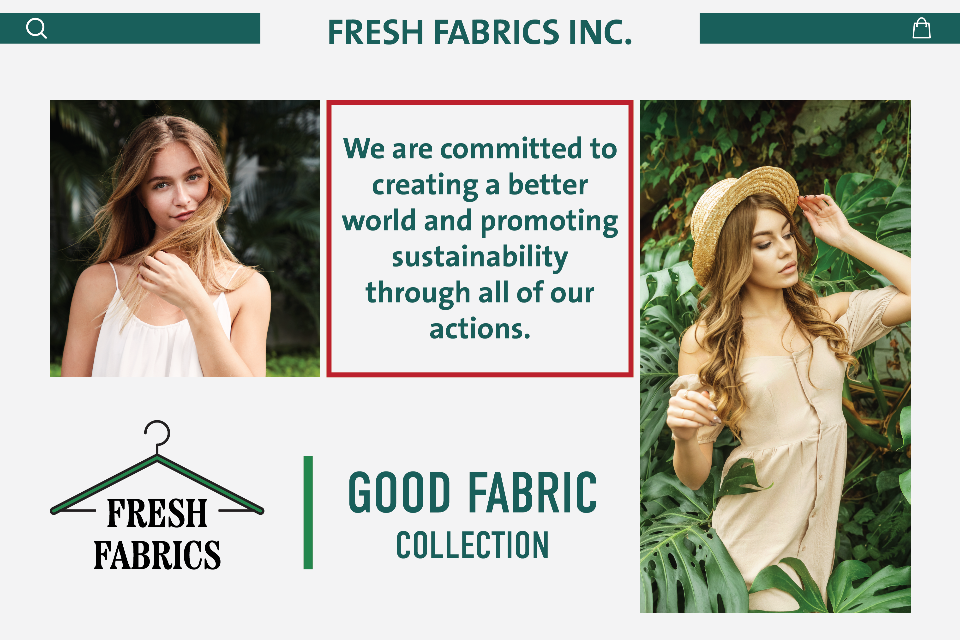
Image description: On a webpage promoting the Good Fabric Collection, Fresh Fabrics Inc. claims to be ‘committed to creating a better world and promoting sustainability through all of our actions’. The site includes images of models shown with leafy green backgrounds.
Think about the overall presentation of claims
As well as considering all these issues separately, consider the overall presentation of the environmental claims you make in the round. Different misleading claims taken together can have an even greater impact on your customer’s decisions, and make your products and business look better for the environment than they really are.
Put in place processes to make sure your claims are right
You should have internal processes in place to make sure all your environmental claims are accurate and do not mislead consumers. It is good practice that these processes include appropriate policies and regular training for staff, and systems to check your product listings are correct and that particular products meet advertised range criteria. You should:
-
be able to back up any claims you make before you make them
-
have robust, credible, relevant and up-to-date evidence that supports the claims
-
have internal processes in place to minimise and correct mistakes when listing products for sale
Make sure your suppliers can back up claims
Your suppliers should be able to back up the claims you make with evidence. In the fashion sector, this evidence often includes:
-
final scope certificates[footnote 2]
-
final transaction certificates[footnote 3]
Make sure your suppliers can provide relevant certificates on request. It is good practice that you:
-
do regular spot checks of relevant certificates
-
get confirmation from your suppliers that they have read, understood and will comply with your policies and contractual terms regarding environmental claims
-
get either the relevant certificates referred to above or other appropriate confirmation, such as a declaration from your supplier, that product information is accurate, prior to offering products for sale
Check any claims third parties make about their products
You are responsible for any claims made relating to third-party products you sell. You need to satisfy yourself that these claims are not misleading.
If you sell third-party branded products, then you should have in place proper processes to make sure that your third-party suppliers can back up the claims they are making about their products. For example, you could require suppliers to complete a self-assessment questionnaire or provide evidence of an independent verification process. Again, each business in the supply chain has a responsibility for ensuring that its claims are accurate and substantiated.
-
Mass balance is a sourcing method that allows the supply chain to mix sustainable material with conventional materials. ↩
-
A document issued by an approved certification body to evidence that a facility is certified to produce Products, fabrics and/or fibres to the relevant given standard. ↩
-
A document issued by an approved certification body to evidence that the Products, fabrics and/or fibres being shipped or received were produced to the relevant given standard. ↩

